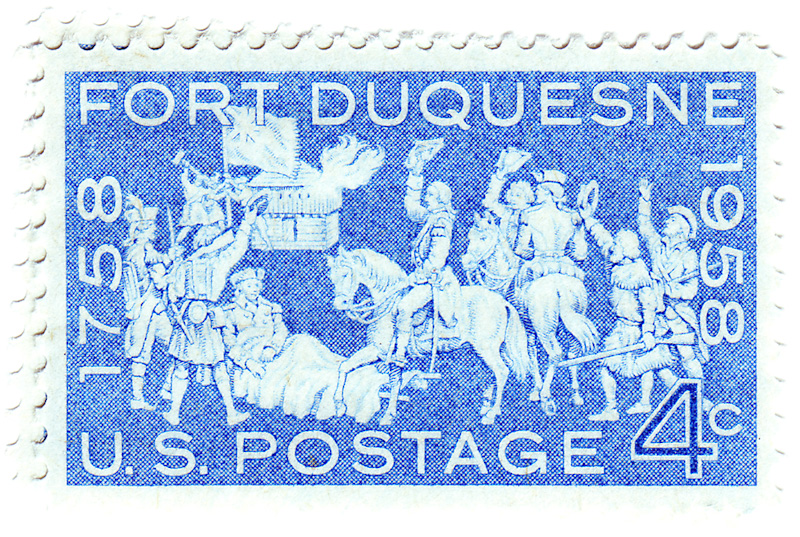Last year at this time, I took a look at the US postage stamp commemorative issues of 1957. Now is time to look at the issues of 1958. Since these issues are themselves retrospective in nature — looking back at events at their 50, 100, 150 or 200 year anniversaries — we’re really look back through two lenses. We’re looking back at the world of 1958, itself looking back at the events of 1858 and 1758.
Postage stamps, like coins, throughout history, have been instruments of propaganda as much as instruments of commerce. It is said that history is written by the victors. If so, the commemorative stamps are created by the great-grand children of those victors. It is interesting to ponder what messages these stamps are delivering, what they say about the dreams and fears of 1958 America, how we romanticize our past and give a exuberantly optimistic view of progress and the future.
This 1958 stamps, from a graphic design perspective, are fascinating. We’ll see here a variety of styles, including stamps design by long-time career designers at the Bureau of Engraving and Printing as well as designs from commercial illustrators. My perception is that we had a greater range of styles back in 1958 than we have today, where now U.S. stamps have a dulling sameness to them.
First up for 1958 was this green 3-cent issue commemorating the centennial of the birth of Liberty Hyde Bailey, a botanist associated with Michigan State and Cornell University.
Aside from his scientific accomplishments, Bailey was a prolific author on horticultural topics and an accomplished prose stylist (as well as a poet). From his 1922 The Apple-Tree:
The apple is a sturdy tree. Short of trunk and short of continuous limb, it is yet a stout and rugged object, the indirectness of its branching branches adding to its picturesque quality. It is a tree of good structure. Although its limbs eventually arch to the ground, if
left to themselves, they yet have great strength. The angularity of the branching, the frequent forking, the big healing or hollow knots with rounding callus-lips, give the tree character. Anywhere it would be a marked tree, unlike any other.
The design of this issue was by Denver Gillen. Note also that Gillen, in 1939, while working in the art department at Montgomery Ward, illustrated the original Rudolph the Red Nose Reindeer children’s book.
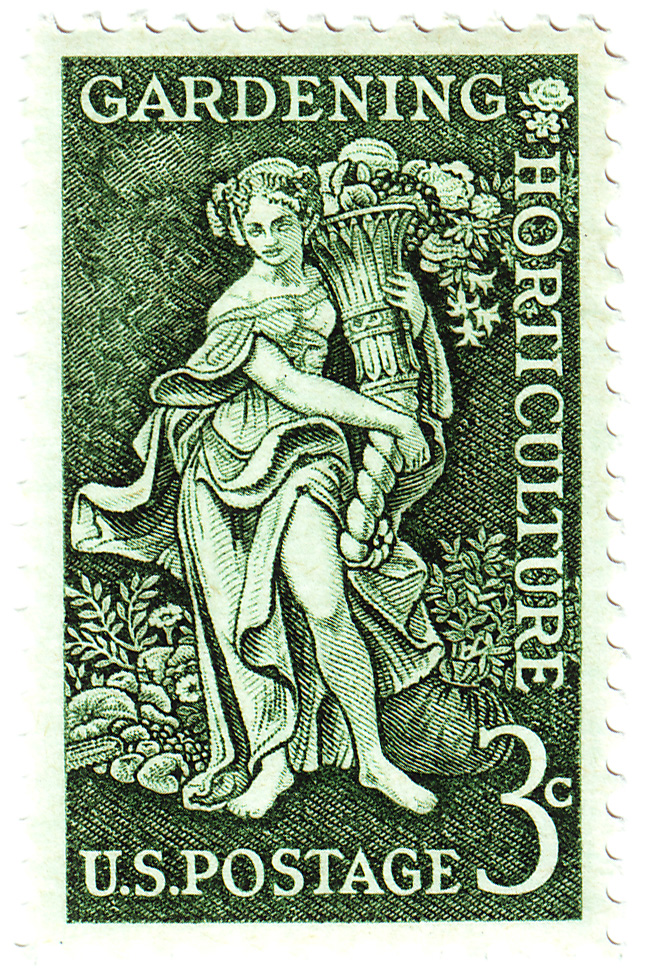
The tradition of World’s Fairs or Expo’s goes back to Prince Albert’s Crystal Palace, and perhaps before. In 1958 the Expo came to Brussels. This stamp was released on April 17th to mark the opening of Expo 58, and shows a view of the United States Pavilion. More notable, and still existing from the Expo, is André Waterkeyn‘s sculpture Atomium, a model of an iron crystal. I wonder if that was featured on any Belgian stamp this year? I know they commemorated the 50th anniversary of the Expo on a special 100 Euro coin.
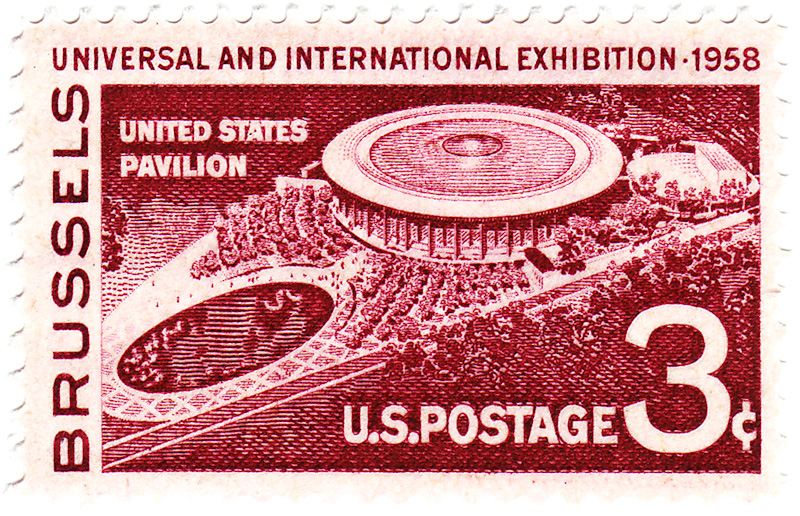
James Monroe. Fifth President of the United States. The Monroe Doctrine. Monrovia, Liberia. Then I draw a blank. We probably spent all of 15 seconds on the Monroe administration when I studied American History. But I can tell you one thing about this stamp, a purple 3-cent issue released on April 28th, 1958, the bicentennial of Monroe’s birth. It was based on a Gilbert Stuart painting now held by the Metropolitan Museum of Art, which you can see here.
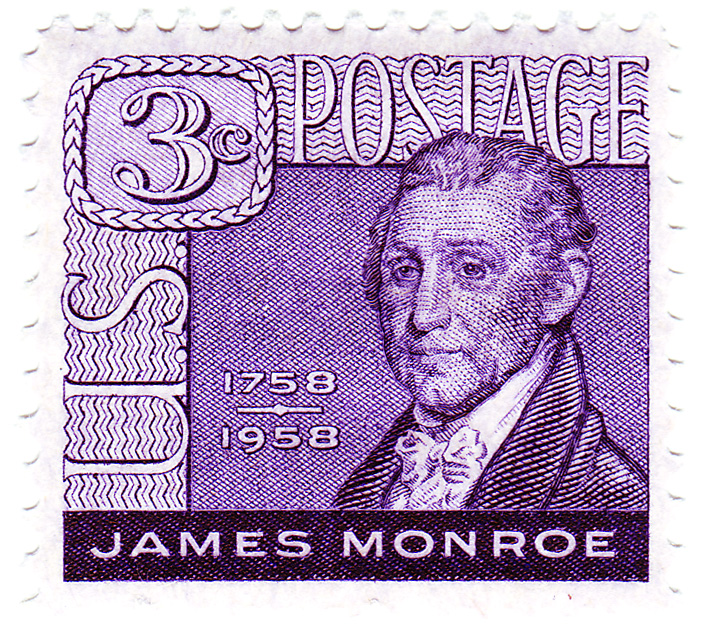
Minnesota became the 32nd state, in 1858. This centenary of this event was commemorated in a stamp design by Homer Hill. I have no information on whether this was an original design or whether it was based on an existing painting or photograph. Let me know if it looks familiar. Is it an artist’s conception? Or is it an actual identifiable location? I’ve only been to Minneapolis, and it sure isn’t there.
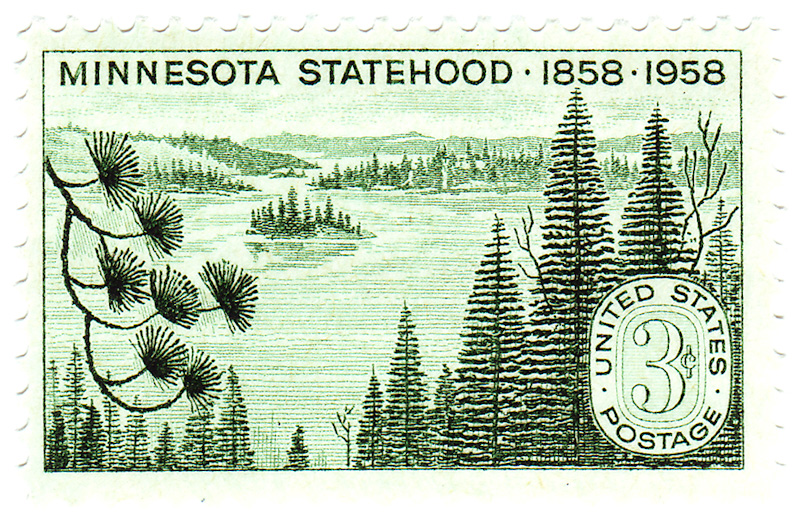
The International Geophysical Year (IGY) invited global cooperation and coordination in the geophysical sciences. Two major accomplishments of IGY were the discovery of the Van Allen Belts and the publication of Pogo’s G.O. Fizzickle.
This stamp was designed by Ervine Metzl, using a portion of Michelangelo’s Creation of Adam and a coronagraph image of the Sun. This was printed via the Giori press. This is one of my favorites of 1958. I like the contrast and use of color.
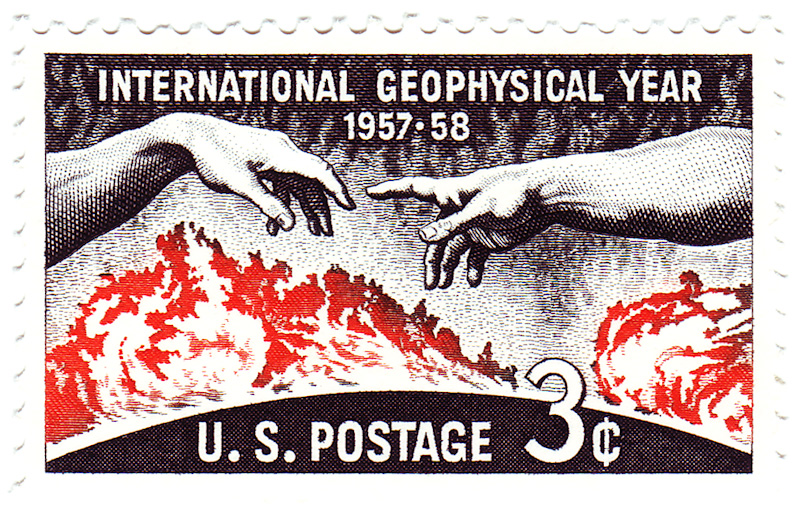
Gunston Hall, the home of George Mason. Although Mason, sometimes called the “Father of the Bill of Rights” is notable in his own right, this stamp was issued to mark the bicentennial of his home, Gunston Hall.
Interestingly, George Mason University’s mascot is named “Gunston”, though he is green and furry and in general has very few Georgian architectural elements.
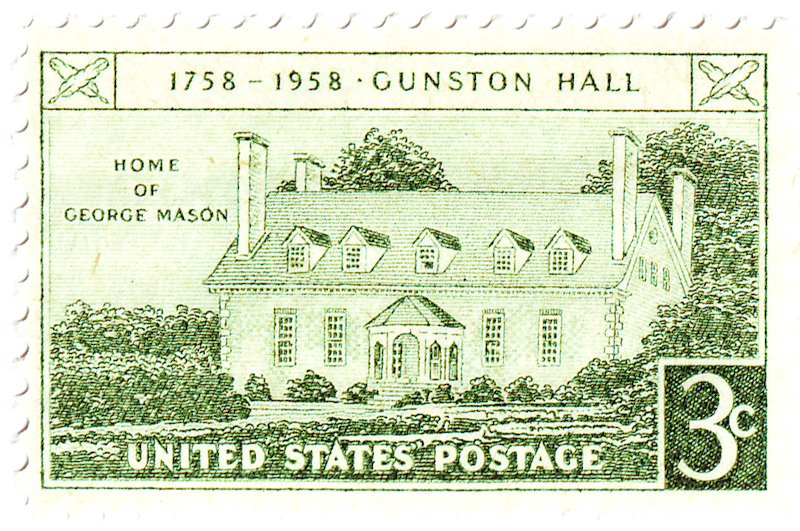
It is pronounced like “Mac-i-naw”. One may forgive the odd pronunciation when reminded that we are thus saved from attempting the native name, which was “Michilimackinac”. It may not be generally known outside of North American, but the state of Michigan is unique in that it formed from two non-contiguous parts, with the northern portion, called the Upper Peninsula, jutting out of Wisconsin, and sharing no land border with Michigan’s Lower Peninsula. After nearly a century of talking about it, the “Mighty Mac” finally bridged the Straights of Macinaw, allowing the Yoopers (those who live in the Upper Peninsula) and Trolls (those who live south of the bridge) to visit without the dreaded detour through the land of the Cheeseheads.
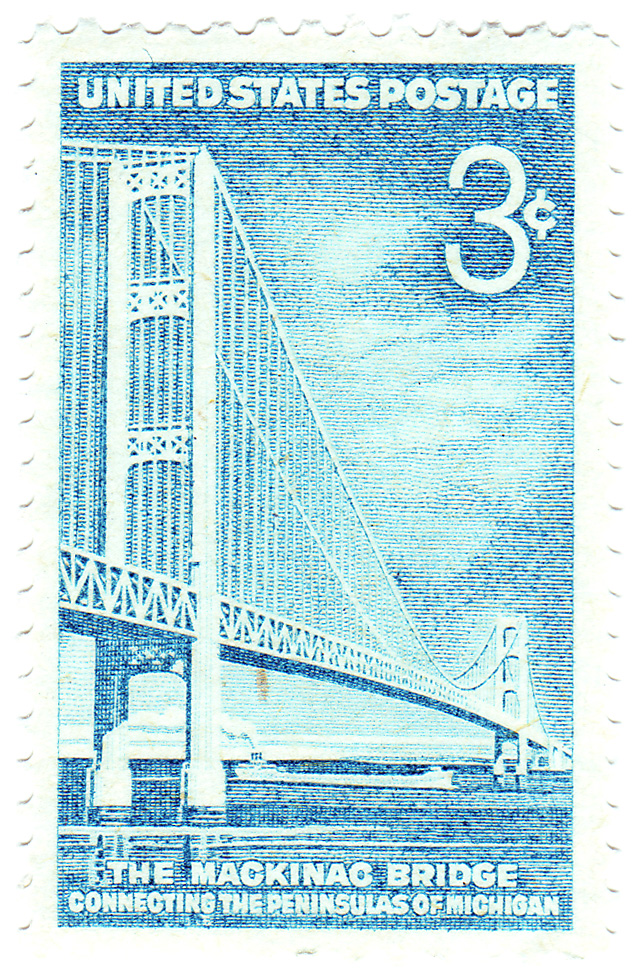
Next up is a bridge of another kind. This issue commemorates the centenary of the trans-atlantic cable which first ran from Newfoundland to Ireland.
One of the first ceremonial messages, send from President Buchanan, can be read as an early affirmation of net neutrality:
To Her Majesty Queen Victoria, Queen of Great Britain: The President Cordially reciprocates the congratulations of Her Majesty the Queen on the success of the great international enterprise accomplished by the science, skill and indomitable energy of the two countries. It is a triumph more glorious, because far more useful to mankind, than was ever won by conqueror on the field of battle. May the Atlantic telegraph, under the blessing of heaven, prove to be a bond of perpetual peace and friendship between the kindred nations, and an instrument destined by Divine Providence to diffuse religion, civilization, liberty, and law throughout the world. In this view will not all nations of Christendom spontaneously unite in the declaration that it shall be for ever neutral, and that its communications shall be held sacred in passing their places of destination , even in the midst of hostilities?
The design is by George Gusti, better known for his magazine covers for Fortune, Time and Holiday magazines. Here he takes on classical figures — Neptune/Poseidon and an oceanid (Amphitrite?) — but with a modern, even futuristic design. In contrast, look at a more conventional depiction, a 1936 Australian stamp commemorating the laying of a cable from Australia to Tasmania. In comparison, Giusti’s design is bold, fresh and modern.
Note also the rate increase to 4-cents, which took effect August 1st, 1958. The previous rate increase, from 2 to 3-cents was in 1932.
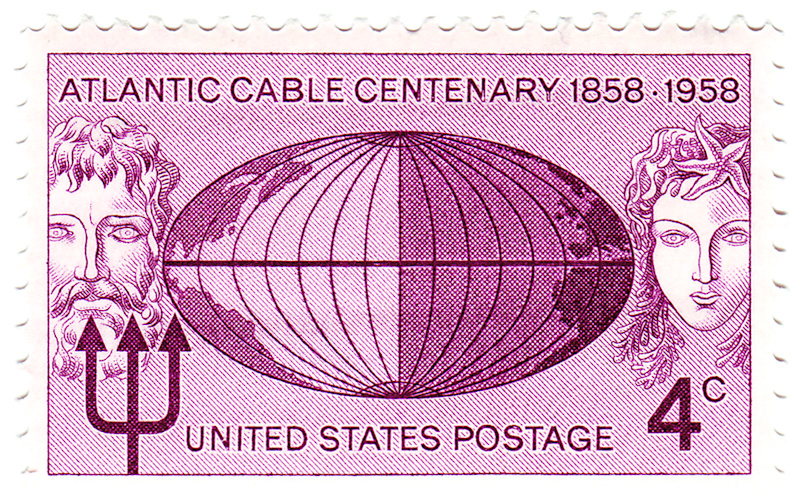
1959, not 1958, was the big Lincoln year. 1959 was the secquicentenital (150th anniversary) of Lincoln’s birth, a year that saw several Lincoln stamp issues, as well as a new design of the reverse of Lincoln Cent. I expert we’ll see new Lincoln stamps in 2009, for the bicentential, as well as the already-announced four new designs for the penny reverse.
But 1958 was the 100’s anniversary of the Lincoln-Douglas debates. It seems that every election year, the presidential debates are inevitably compared to these famous debates. But although the format may be similar in structure — statement, counter-statement and rejoinder — the scale of the Lincoln Douglas debates was much larger. They had a series of seven debates, over a period of two months. In each debate, the first candidate spoke for 60 minutes, followed by a 90 minute counter-statement by his opponent, concluding with a 30 minute rejoinder by the initial speaker. In comparison, modern presidential debates are trite affairs, little more than posturing and sound bites.
The design of this issue was by Ervine Metzl, based on an original by Joseph Boggs Beal.
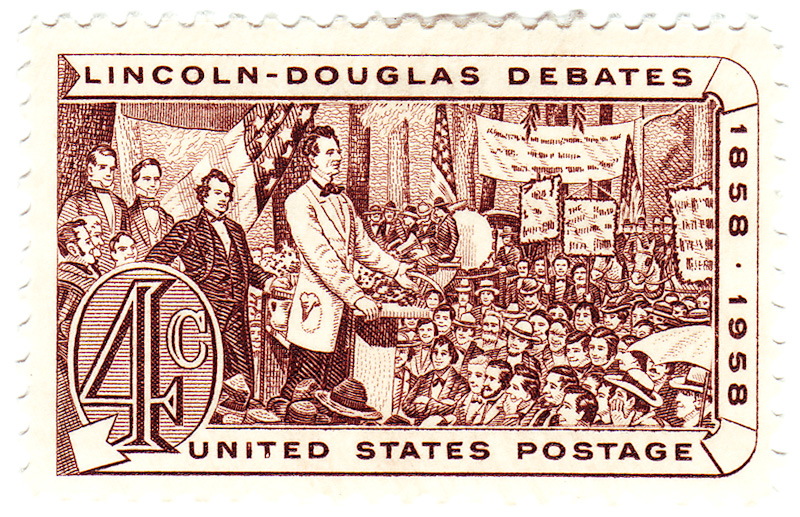
Freedom of the Press. OK. We’re all in favor of that. But why commemorate it in 1958? The fundamental right is in the Bill of Rights, ratified in 1791. Before that the Massachusetts Constitution (1780) and the Virginia Declaration of Rights (1776) also affirmed the freedom of the press. But none of this hit major anniversary dates in 1958. So what is going on here?
The real occasion of this stamp is the 50th anniversary of the founding of the School of Journalism at the University of Missouri — the first journalism school in the world.
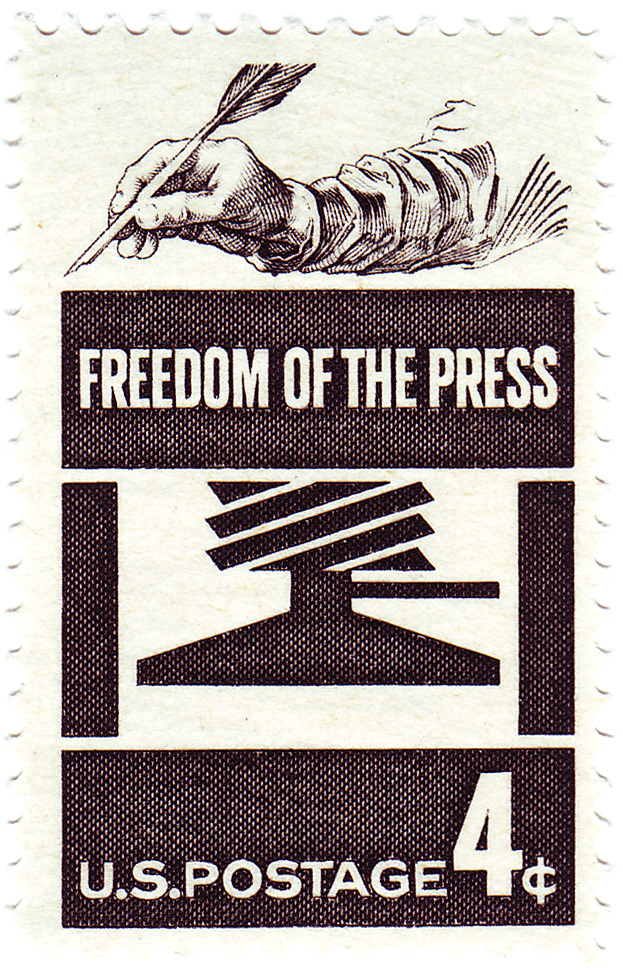
There were several regular, scheduled overland postal routes in operation in 1857-1858. James E. Birch had a line that ran from New Orleans to San Diego, and John Butterfield had a route from St. Louis to San Francisco. Butterfield’s operation proved to be the more successful, and this commemorative stamp illustrates his route in the background,
The original design for this issue was done by Bureau of Engraving and Printing veteran Charles Chickering.
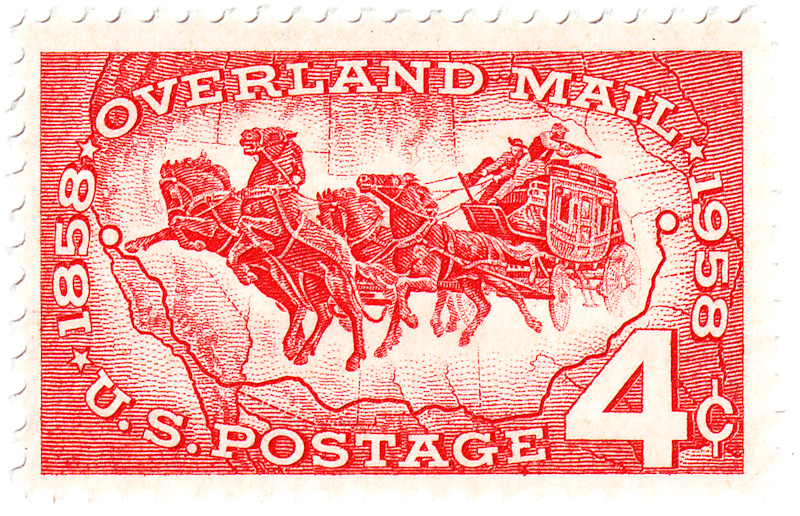
Noah Webster was the dictionary guy, not to be confused with New Hampshire statesman/orator Daniel Webster. 1958 was the bicentennial of Noah’s birth. We can thank Noah for the American spelling reform of words like color, center and defense. The design, by Charles Chickering, is based on an engraving held by the National Portrait Gallery.
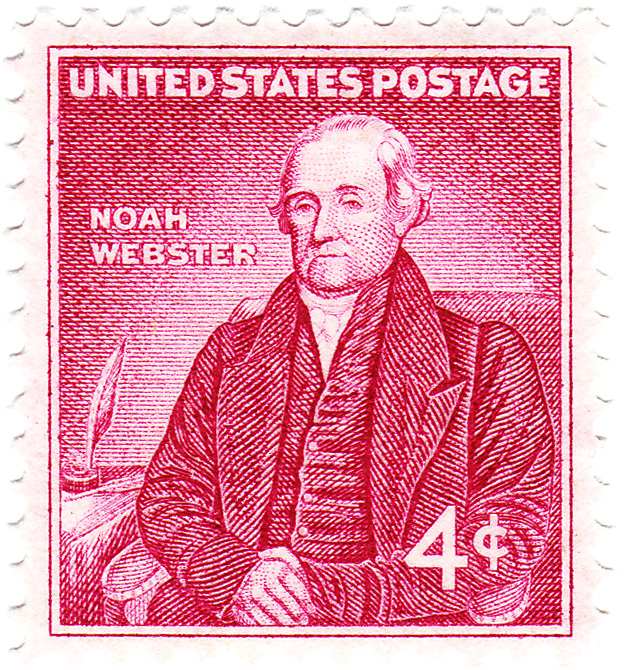
The 1958 Forestry Conservation stamp was designed by Rudolph Wendelin, a career artist for the U.S. Forestry Service, best known as the artist behind Smokey the Bear posters and other graphics, from 1944 to 1973.
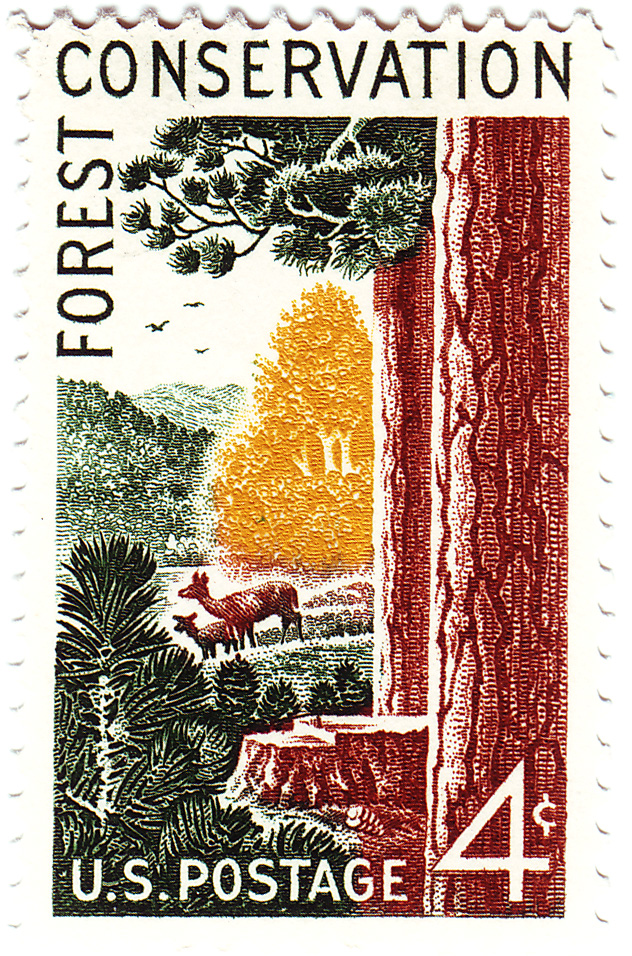
Fort Duquesne was located in what is now Point State Park in down-town Pittsburgh. George Washington, then a Lt. Colonel in the Virginia Militia, campaigned against Fort Duquesne, unsuccessfully. Soon after the fort was set afire and abandoned by the French in the face of advancing troops lead by Brigadier General John Forbes, who then occupied what was left of the fort on November 25th, 1758. Forbes health declined soon after and he was dead three month later.
So the English victory was not great. But what warrents commemoration is that from the ashes of Fort Duquesne sprung a new fort, named for William Pitt the Elder. And Forbes named the settlement outside of Fort Pitt “Pittsborough” or as we call it today, “Pittsburgh”.
The stamp was based on figures from a 19th century engraving “Washington Raising the British Flag at Fort Du Quisne”.
